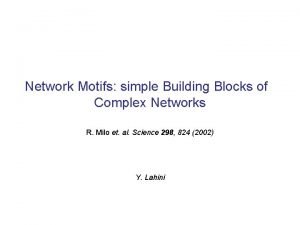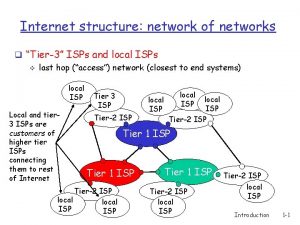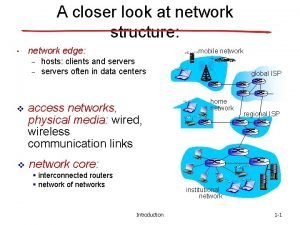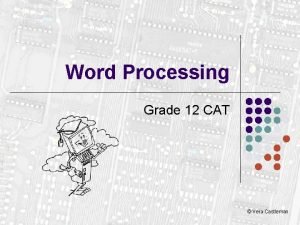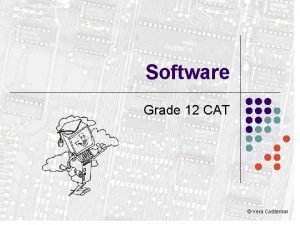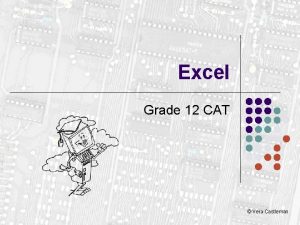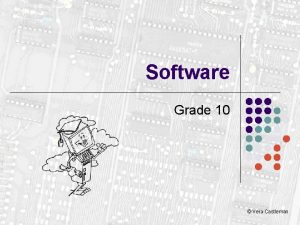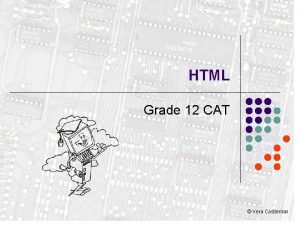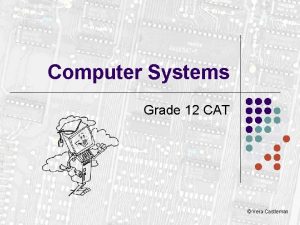Networks Grade 10 Vera Castleman The Network System









- Slides: 9

Networks Grade 10 © Vera Castleman

The Network System l l A network links components electronically. Each component is a NODE. A node could be: l l A PC A printer A modem etc. The essential components of a network are l l Network devices (e. g. computers, printers) Communication channels (e. g. cables) Network interface cards Network software.

Types of Networks l Networks can be: l l Simple two computers at home could be linked directly. If both have the same control called a peer-to-peer network. Complex server based the server controls the components linked together in the network.

Advantages of a network l l l l Share Resources Centralise and update data in one place Centralise programs on server Upgrades can be done in one place Files transfer is easy. Contact maintained by using e-mail which can also update Inter-Office appointments. Security is maintained sensitive material is restricted from general use. Networks save time and resources. They improve productivity and also save money.

Disadvantages of a network l l are always a concern in a network. A well managed network will restrict unauthorised users Each user will have a profile protected by a password. Rules for creating a password l Don’t use things that a user can guess like a pet’s name, a boy or girl friend’s name, your birth date etc. l Change your password regularly especially if you think it has been guessed. l Never use a sequence of letters or numbers (e. g. 12345 or abcde) l Use an alphanumeric code l Make some of the letters uppercase l Substitute numbers for some of the letters Sabelo 8 Ab 310 l DO NOT write it down!

Black, Grey and White Hats l l l Black Hats gain access to try to steal or destroy information They will leave a message so that people will know that they have been in. Grey Hats ½ a White and ½ a Black Hat. They enjoy the challenge of breaking in – will usually inform the company and suggest payment for providing a fix for the security breach. White Hats will do it for a challenge and will let the company know how to fix it.

Examples of networks l l l PAN (Personal Area Network) e. g. pictures taken with your cell phone can be sent to your printer. HAN (Home Area Network) 2 or more PC’s in a home are connected to share resources, OAN (Office Area Network) a small office connecting as above LAN (Local Area Network) exists in a company within a small geographical space e. g. one office complex. WAN (Wide Area Networks) cover a vast geographical span e. g. between offices and the head office, various colleges of a university etc. GAN (Global Area Networks) refers to the internet or a company with ties to a company in another country usually via satellite.

Communication Channels l l l l Telephone lines Coaxial Cables UTP cabling Microwave Transmission Fibre Optic cables Infrared Transmission Cellular Radio Systems

Communications Interfaces l An interface is a piece of hardware that helps various devices to communicate. There are many ways that different communication components can be linked: l l l Modem Switch Router
 Castleman power
Castleman power Packet switching datagram and virtual circuit approach
Packet switching datagram and virtual circuit approach Backbone networks in computer networks
Backbone networks in computer networks Palo alto networks certified network security engineer
Palo alto networks certified network security engineer Principles of network applications
Principles of network applications Network motifs: simple building blocks of complex networks
Network motifs: simple building blocks of complex networks The network layer is concerned with
The network layer is concerned with Tier 3 isps
Tier 3 isps Internet structure network of networks
Internet structure network of networks Network layer design issues
Network layer design issues





